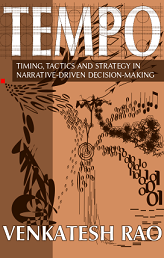The paradox of creative destruction is that some of the most vibrant environments — like raw nature and the startup scene — are also the ones that best showcase those Darwinian dynamics. I mean, just look at the smiling faces here at the Seed Hatchery, a Memphis startup incubator co-founded by Eric Mathews, the guy in the blue t-shirt at the head of the table in the back. I cadged an invitation to their regular Founders Dinner via Daniel Pritchett. These guys — about a half-dozen entrepreneurial teams — have just had a round of grilling from an experienced entrepreneur (Tom Federico, the other guy at the head of the table, founder of TeamRankings.com — he was surprisingly gentle, compared to some of the bloodier such scenes I’ve witnessed) and are still all smiles. I rarely find such all-around smiling in bigger companies. Okay, I provoked that by saying “Everybody say ‘Series A’,” but I bet you they’d still be smiling if I’d yelled “9 out of 10 of you will fail!” Heck, they’d probably be laughing.
What’s more, they are aware of grim realities like that. They even put up cues to remind them of the fact. Here’s their countdown clock till their investor day.
They already know that for some of them, this will be the end of the road. At least for whatever idea they are pursuing right now. Between infant mortality right out of places like Seed Hatchery, and death by old age as a large company with an obsolete business, every one of the business ideas in the picture above is going to eventually die. Contrary to the popular image of the entrepreneur as a delusionally optimistic breed, I find that among the ones I meet, the ones with the clearest perception of this stark reality tend to have the soundest strategic thinking in their business plans. Based on anecdotal evidence, I’d say they are also the most successful ones. There is a sense of intrinsic, organic urgency to their thinking that exists quite independently of such extrinsic urgency drivers as countdown clocks. It is an energizing, Sisyphean kind of fatalism.
Now that I’ve shifted over from the gold-miner side to the selling-pickaxes side in the entrepreneurship game via writing on themes relevant to entrepreneurship and product marketing/launch consulting, I find a grim sort of solace in contemplating truly intense creative destruction close up (not that writing/consulting careers are immune to the creative destruction cycle; they just have a less intense cycle).
Maybe that’s why I like to go around taking pictures of both rusting infrastructure and things bursting with youthful vigor. For those of you who have gotten through most of Tempo, you know that the book is based at a very fundamental level around mortality-driven (as opposed to immortality-driven) thinking and creative destruction. I think the reason mortality-driven narrative frames work to guide decision-making well is that they lend the right emotional tones to your actions. The right kind of tempo begets the right kind of sense of urgency appropriate for each phase of a birth-to-death story, and catalyzes the right kind of energy.






Thank you for coming through Memphis on your tour! I regret being unable to give you more time and a more extensive tour but it was great to finally meet you in person.
I’m sure the Seed Hatchery teams appreciate getting the chance to air out their plans in front of a few new faces.
Thanks for stopping by at seed hatchery. Will definitely be checking out your book which promises to make for interesting reading.
I would characterize the entrepreneurial spirit as Promethean rather than Sisyphean — as far as Sisyphus goes, I think Camus has him right more than any of the tragic interpreters of Sisyphus. In a sense all entrepreneurs are Camus-nist if you pardon the expression. Seems to me they are all rebelling against their condition and despite all perceived optimism have an enlightened view of the limits of their condition — they aspire not for the impossible but aim to exhaust the limits of the possible. One can only imagine them happy.